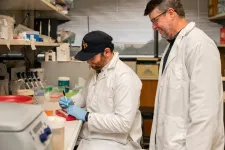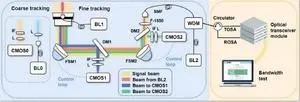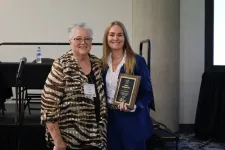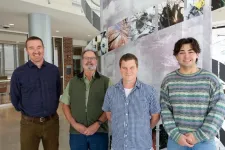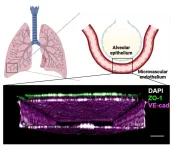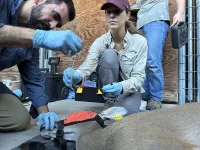(Press-News.org) A team of researchers at the Texas A&M University School of Veterinary Medicine & Biomedical Sciences (VMBS) has received a grant from the National Institutes of Health (NIH) to research metabolism in people with Down syndrome.
By targeting genes that affect metabolism, the team may be able to develop drug therapies for physical and mental symptoms of the condition, like muscle loss, accelerated aging, and lower cognitive function, thereby improving the quality of life for people with Down syndrome.
The new grant will also make Dr. Weston Porter, a professor in the VMBS Department of Veterinary Physiology & Pharmacology and lead researcher on the project, one of the highest NIH-funded researchers at Texas A&M.
Making Connections
Down syndrome is a genetic condition that affects approximately 1 in every 700 fetuses and can cause varying degrees of physical, mental, and developmental disability. There are currently about 400,000 people with Down syndrome living in the United States.
Porter’s interest in studying Down syndrome came by way of breast cancer research, which he’s been conducting for over 20 years.
“Part of our lab team works on a protein called SIM2 and its relationship to breast cancer,” Porter said. “SIM2 happens to be in the middle of a section of chromosome 21 that we call the ‘Down syndrome-critical region.’ Almost every individual with Down syndrome has an extra copy of this gene.”
Genetic conditions like Down syndrome are closely linked with changes in tumor and cancer profiles, like breast cancer, according to Porter.
“Primarily, we see an increase in tumor incidents in individuals with genetic diseases. For example, people with Down syndrome are more likely to develop leukemias and lymphomas. However, breast cancer is extremely rare for these individuals,” he said.
Porter and his team of researchers have previously been awarded grants to study the intersection of breast cancer and Down syndrome. The team studied the role of SIM2 in providing people with Down syndrome increased resistance to breast cancer because of Down syndrome’s triplication of certain genes.
“Having SIM2 offers a sort of protective mechanism against breast cancer, but the over-expression of SIM2 leads to the development of other health concerns,” said Lilia Sanchez, a graduate student in Porter’s lab. “Our goal is to better understand the role SIM2 plays and also how much is too much so that we can develop therapies that help combat diseases related to both the over- and under-expression of SIM2.”
The lab’s research into the connection between breast cancer and SIM2 led them to believe that the protein might also be involved in regulating crucial metabolic factors in Down syndrome.
“Many of the phenotypic elements of Down syndrome — the physical and mental manifestations like muscle loss, increased chance of Alzheimer’s and Parkinson’s diseases, developmental disability — are linked to changes in metabolism,” Porter said. “The reason for this is that the cells’ mitochondria, which help regulate metabolism, are constantly running at full steam in Down syndrome. It’s like running the car engine all the time.”
Likewise, the changes in metabolism that people with Down syndrome experience come from having an overexpression of SIM2.
“When SIM2 is overexpressed, we see that it ramps up the mitochondria — you’re turning it on, but you cannot turn it back off,” he said. “That results in mitochondrial dysfunction.”
Multi-faceted Mitochondria
Contrary to what most people remember from high school, mitochondria aren’t just powerhouses for cells. They play a role in a number of cellular processes, which is one reason that metabolism is so interconnected with Down syndrome.
Sanchez has published researched describing how SIM2 regulates mitochondria during periods of stress. Her research examined SIM2’s role in regulating mitochondrial health in breast tissues during lactation, which is a stressful time for mammary cells.
“The main takeaway from this paper is that mitophagy, which is the recycling of mitochondria, is a normal process that naturally happens in tissues that are highly active,” Sanchez said. “Mitophagy is also involved in the stress response of the cell, and our data suggest that SIM2 regulates the rapid recycling of mitochondria, thus enhancing functions accompanied by higher stress, such as lactation.”
SIM2 also impacts mitochondria in other ways, according to Dr. Steven Wall, a former graduate student in Porter’s lab.
“SIM2’s role in electron transport is the most novel thing we found,” said Wall, who served as the lead author for another publication produced by the lab. “Previously, it was not known to be involved in the electron transport chain, yet we found it consistently in the mitochondria and in the electron transport chain.”
Since the electron transport chain is a fundamental part of how the mitochondria regulates energy, it’s clear that SIM2 has the ability to regulate some of the most important functions within our cells.
Combined with SIM2’s rapid recycling effect on mitochondria, it also appears to be crucial for understanding Down syndrome.
Transforming Life With Down Syndrome
While the new grant will specifically look at SIM2’s role in regulating skeletal muscle metabolism, Porter also hopes that the project will lead to studies of other parts of the body and will eventually make new therapies available to people with Down syndrome.
“Given the amount of research happening on genetic diseases right now, it’s becoming much more possible to develop drugs for those diseases,” he said. “Working with Down syndrome is tricky because there are 20 to 30 genes changing, but, incrementally, we hope to improve people’s quality of life.”
Porter and his team are also developing ways to involve the Down syndrome community in offering feedback and ideas for future research directions.
“We want to know their concerns so that we can prioritize research that addresses them,” he said. “They can help us decide which aspects of life with Down syndrome to focus on next in our research — things like improved mobility, cognitive function, or life expectancy.”
Ultimately, Porter believes the new study will have a big impact for people with Down syndrome.
“It’s going to be transformative,” Porter said.
###
By Courtney Price, Texas A&M University School of Veterinary Medicine and Biomedical Sciences
END
Researchers receive NIH grant to improve quality of life for people with Down syndrome
2023-10-17
ELSE PRESS RELEASES FROM THIS DATE:
Miniaturized FSO breakthrough unlocks high-speed wireless communication anywhere
2023-10-17
In a world that relies on high-speed internet and seamless communication, the absence of a reliable fiber connection can be a significant hurdle. Fortunately, a cutting-edge technology known as free-space optical communication (FSO) offers a flexible solution for field-deployable high-speed wireless communication in areas where fiber connections are unavailable.
FSO has garnered attention for its versatility across various scales of operation. On a global level, it plays a crucial role in establishing high-speed satellite internet projects like Starlink, ensuring global connectivity. At the ground level, ...
Pennington Biomedical’s Dr. Leanne Redman selected for top honor by The Obesity Society
2023-10-17
BATON ROUGE – The Obesity Society – the leading professional society focused on obesity science, treatment and prevention – has named Pennington Biomedical’s Dr. Leanne Redman as the recipient of the 2023 TOPS Research Achievement Award. The award, which is funded by the Take Off Pounds Sensibly, or TOPS, Foundation, was presented to Dr. Redman on Monday, Oct. 16, in recognition of her contributions to research in the field of obesity.
Considered by many to be the top award for obesity research, Dr. ...
New technique helps robots pack objects into a tight space
2023-10-17
CAMBRIDGE, Mass. -- Anyone who has ever tried to pack a family-sized amount of luggage into a sedan-sized trunk knows this is a hard problem. Robots struggle with dense packing tasks, too.
For the robot, solving the packing problem involves satisfying many constraints, such as stacking luggage so suitcases don’t topple out of the trunk, heavy objects aren’t placed on top of lighter ones, and collisions between the robotic arm and the car’s bumper are avoided.
Some traditional methods tackle this problem sequentially, guessing a partial solution ...
Mitochondrial protein plays key role in glioblastoma and therapeutic resistance
2023-10-17
Glioblastoma is the most common type of brain tumor that affects adults and, unfortunately, still remains incurable. In a new study, researchers have demonstrated that a specific mitochondrial protein plays an important role in glioblastoma, and can therefore be used as a potential target to reduce tumors.
“Glioblastoma is notorious for its lethality. One of the major challenges is that it spreads invasively throughout the brain. We’re interested in understanding what drives this process in order to identify new therapeutic strategies,” said Brendan Harley (RBTE leader/EIRH), the Robert W. Schaefer Professor of Chemical ...
Whaling wiped out far more fin whales than previously thought
2023-10-17
Key takeaways
Whaling in the 20th century destroyed 99% of the Eastern North Pacific fin whale breeding population.
Because there is enough genetic diversity, current conservation measures should help the population rebound without becoming inbred.
The future of fin whales in the Gulf of California depends on the recovery of the Eastern North Pacific population.
A new genomic study by UCLA biologists shows that whaling in the 20th century destroyed 99% of the Eastern North Pacific fin whale breeding, or “effective,” population — 29% more than previously thought.
But there is also some good news: Genes among members of this endangered ...
Human Lung Chip leveraged to faithfully model radiation-induced lung injury
2023-10-17
By Benjamin Boettner
(Boston) — The lung is one of the tissues most sensitive to radiation in the human body. People exposed to high radiation doses following nuclear incidents develop radiation-induced lung injury (RILI), which affects the function of many cell types in the lung, causing acute and sustained inflammation, and in the longer term, the thickening and scarring of lung tissue known as fibrosis. RILI also is a common side effect of radiation therapy administered to cancer patients to kill malignant cells in their bodies, and can limit the maximum radiation dose doctors can use to control their ...
Texas A&M receives over $1 million in USDA grants to study SARS-CoV-2 in deer
2023-10-17
Texas A&M University scientists and research partners have received two National Institute of Food and Agriculture (NIFA) Agriculture and Food Research Initiative (AFRI) grants to study the spread of SARS-CoV-2 in deer. These funds will help researchers understand the impact of the virus in Texas’ deer populations and its relationship to human and ecological health.
For these projects, the research team will focus on captive deer, which are an agricultural species in Texas, including managed deer that live on large, rural properties enclosed by fences, as well as on the wild deer with which captive deer may interact and deer living ...
SwRI develops novel solution to advance synthesis for nerve agent antidotes
2023-10-17
SAN ANTONIO - October 17, 2023 — Southwest Research Institute has developed a unique technology (US20230242487A1) that enables the safe and efficient synthesis of organophosphorus nerve agent (OPNA) oxime antidotes. Using this technology, SwRI scientists can not only successfully synthesize currently known highly effective nerve agent countermeasures, but also effectively develop promising new drug candidates to treat nerve agent exposure.
Current treatments for OPNA exposure have not changed significantly since the 1950s. OPNAs are odorless and colorless chemicals ...
The Foundation for Angelman Syndrome Therapeutics to advance gene therapy candidate through IND-enabling studies conducted in partnership with the University of Pennsylvania
2023-10-17
October 17, 2023—The Foundation for Angelman Syndrome Therapeutics (FAST) announced today that the non-profit organization has entered into an exclusive global collaborative research and development agreement with the University of Pennsylvania to develop an investigational adeno-associated virus (AAV) gene therapy for Angelman syndrome (AS).
Angelman syndrome is a nondegenerative neurogenetic disorder that is estimated to impact approximately 1 in 15,000 births, or potentially 500,000 individuals world-wide, ...
Harnessing molecular power: electricity generation on the nanoscale
2023-10-17
WASHINGTON, Oct. 17, 2023 – Wave energy technology is a proven source of power generation, but there is power inherent in every molecule of liquid on earth, even when the liquid is at rest. At the molecular scale, atoms and ions are always moving. If this nanoscale movement can be harvested, it could be a big source of energy.
“There are vast amounts of air and liquid on the earth, and their successful harvesting could produce a gigantic amount of energy for society,” author Yucheng Luan said.
In an article published this week in APL Materials, by AIP Publishing, Luan and his collaborators tested a molecular energy harvesting device that captures ...
